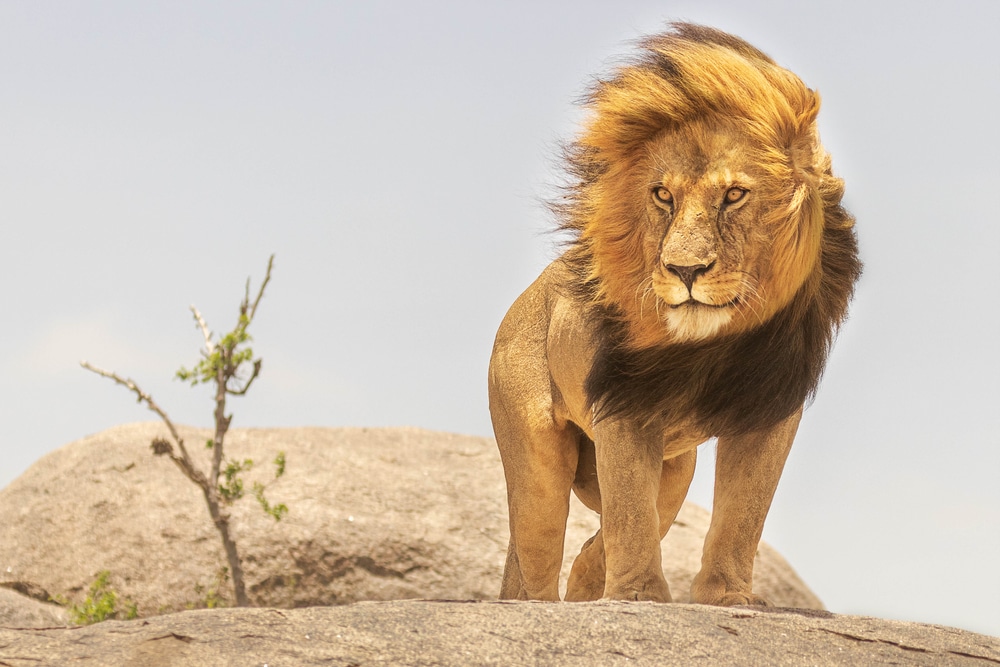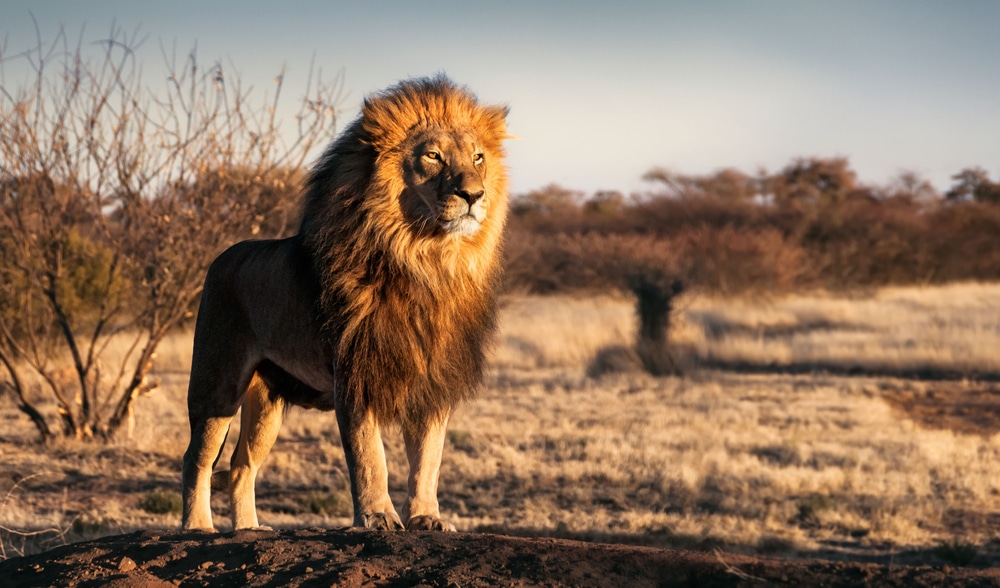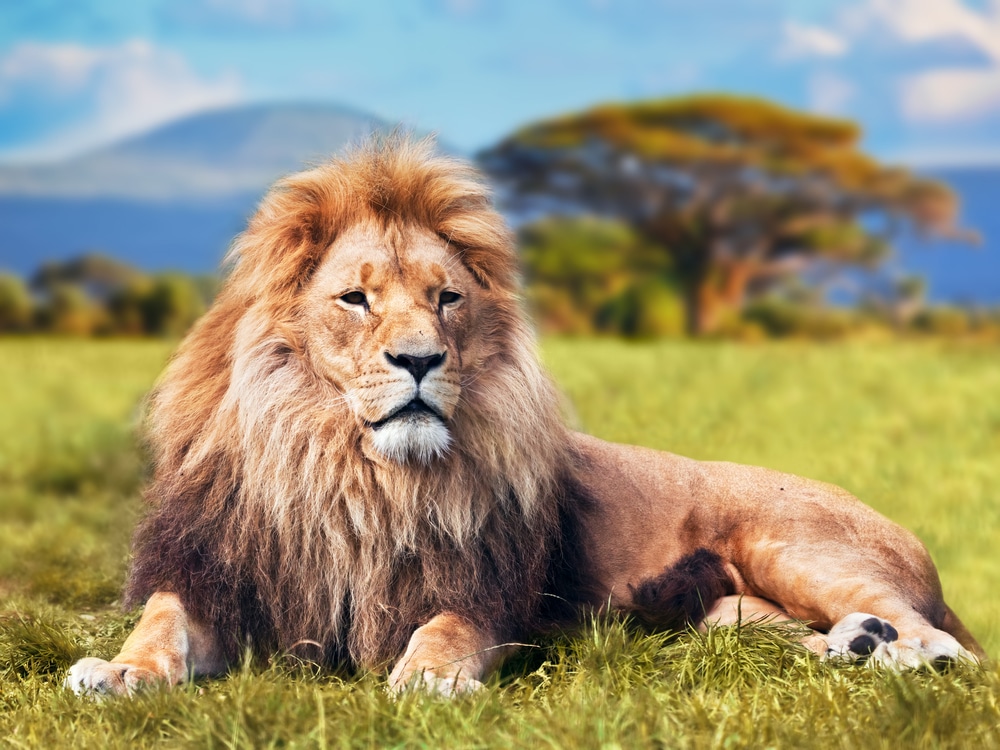
Lions command attention and admiration. This is not just for their presence but also for the defining feature that has captured the human imagination for centuries: the lion’s mane. This resplendent crown of thick, luxurious hair adorning the head and neck of male lions is an emblem of power, virility, and majesty in the animal kingdom.
Male lions begin to grow manes at around age two, and this signals the onset of sexual maturity. This transformative phase signifies a transition from adolescence to adulthood in male lions and is often accompanied by changes in lion behavior and pride dynamics.

Lions go through several stages of mane development, and the timing and appearance of their manes can vary between individuals. Here is a quick look at the life cycle of a lion’s mane from birth to adulthood:
When lion cubs are born, they are completely maneless. Both male and female cubs look very similar in appearance. The mane begins to develop around 3 to 4 months of age, and at this stage, it's very short and light in color, often resembling a fuzzy collar.
As the cub grows, the mane becomes more noticeable and starts to darken in color. This mane covers the neck and part of the shoulders, but it is not yet fully developed. Sub-adult males may start to exhibit tufts of hair on their elbows and around their ears, which are early signs of the mane's growth.
By the time lions reach 2 to 3 years of age, their manes are more prominent and cover a larger portion of the neck and shoulders. The mane continues to darken and thicken, becoming more defined. It is during this stage that the difference between males and females becomes more apparent.
Young male lions, around 3 to 4 years old, usually have a well-developed mane that covers most of their neck, and it extends down the chest and back. The mane's color becomes darker and richer, ranging from light brown to almost black. These young males may start challenging older males for mating and dominance within the pride.
As lions reach full adulthood, usually around 4 to 5 years of age, their manes are at their most impressive. The mane continues to grow and darken, often reaching its maximum length and fullness around 5 to 6 years old. The mane serves as a symbol of maturity and dominance among male lions and plays a significant role in attracting mates. The exact appearance and size of a lion's mane can vary between individuals and is influenced by genetics, health, and environmental factors.

As male lions reach sexual maturity, typically around 2 to 3 years of age, their testosterone levels increase significantly. This surge in testosterone promotes the growth and thickening of the mane. Testosterone also influences the darkening of the mane's color, making it more visually striking. The change in appearance signals to both potential mates and rival males that a lion is entering adulthood and is ready to compete for mating opportunities and pride leadership.
Lion manes are generally there to impress potential mates and intimidate potential rivals. But not all manes are created equally – some are more impressive than others. According to one study, female lions often prefer males with darker and more impressive manes, as this can be genetic fitness and health indicators, as well as the ability to provide and protect the pride. During courtship, male lions use their manes in displays to catch the attention of females.
At the same time, the mane also intimidates other male lions and helps establish dominance. Lions with larger, darker, and more impressive manes are perceived as more formidable and assertive leaders within the pride. They are more likely to win disputes over territory, food, and mates. The mane serves as a visual signal of a lion's dominance, deterring rival males from challenging their authority.
In the event of a fight, the mane can provide protection. While the mane doesn't provide physical protection like armor, it can offer some defense during fights with rival males. The thick hair can help absorb the impact of blows and bites, reducing the risk of injury to the head and neck during aggressive encounters.

The size, density, and color variations of a lion's mane are influenced by a combination of genetic, environmental, and hormonal factors. Here's a breakdown of the key factors that determine these characteristics:
The genetic makeup of a lion plays a significant role in determining the color, size, and density of its mane. Some lions may carry genes that predispose them to develop larger or darker manes, while others may have genes for smaller or lighter manes.
As mentioned earlier, testosterone is a key hormonal factor influencing mane development. Higher levels of testosterone during adolescence and adulthood lead to the growth and darkening of the mane. However, the exact levels of testosterone can vary between individual lions and can be influenced by factors such as age and health.
The age of a lion plays a critical role in mane development. As lions mature, their manes tend to grow larger, denser, and darker. Typically, the mane becomes most prominent and impressive in adulthood, usually around 5 to 6 years of age.
Lions with access to a consistent and high-quality food source tend to have healthier manes. Malnutrition or periods of food scarcity can result in smaller or less impressive manes. Furthermore, the overall health of a lion can influence mane development. Lions suffering from illness or parasites may have compromised mane growth and quality.
The environment in which lions live can impact their mane characteristics. Lions in hotter, drier climates may have shorter and less dense manes because a large, heavy mane can cause overheating. Conversely, lions in cooler climates may have more substantial manes.
Just as there is variation in human physical traits, there is natural variation in mane characteristics among lions. Some lions within the same pride or population may develop more impressive manes than others due to genetic diversity.The lion’s mane is a banner of dominance. It attracts mates, dictates hierarchy within pride, and deters rivals from challenging the alpha male. If you wish to experience and learn more about lions and their mane, visit us at Lions Tigers & Bears.

Ph: 619.659.8078
Fx: 619.659.8841
[email protected]
24402 Martin Way, Alpine, CA 91901